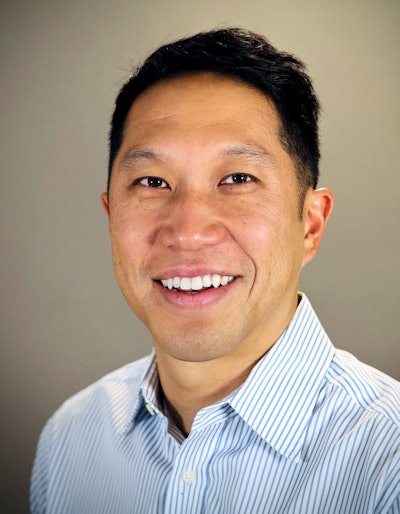
In my previous post, I detailed factors contributing to the extremely labile stress levels that we feel as radiologists -- specifically feeling so busy but finding it difficult to get any "real" work done.
 Dr. Roy Kwak.
Dr. Roy Kwak.Being so busy, yet -- paradoxically -- having a concomitant plunge in productivity. I broke down the causes of this phenomena into the following categories:
- The normal ebb and flow of patient volume
- Fires
- The dump
- Complex cases
- Not being "present"
- Team not being "present"
- Broken systems
I also promised to explain the ideas of the "quantum unit of work" (Q) and the "time tax" (Tt) and how they interact with each other. We'll do that right now ... and then dive into a formula that details the relationship between productivity and all of these variables.
I had previously promised to do this in two parts ... but I lied. Because of the broadness and complexity of this topic, I ultimately decided to break this into three parts. I think the punchline will be worth it.
The quantum unit of work
Like a seamstress, radiologists get paid by the piece. There is no such thing as partial work, and we don't get partial payments. Every imaging study you read has a minimum amount of time that must be spent on it from start to finish.
Of course, some studies take longer to read, and on some days, you are able to read faster than others, but the general concept is unchanged. There is a minimum, nonzero amount of time it takes to open an exam, read the pertinent history, systematically scroll through the images, compare them with priors, generate a report, and close the case.
Certainly, that time varies for different exam types. A screener chest x-ray requires vastly different commitments of time and energy compared with a CT angiography exam with bilateral lower extremity runoffs ... but for any given study, there is a quantum unit of time that must pass before you can be "finished" with that study and move on to the next one. This is especially true for cross-sectional exams.
This minimum time block to read a study in an optimized situation is what I call the "quantum unit of work" (Q). It determines your maximum reading rate.
Now, in an ideal world, we would all be blazing through our worklists, ringing that reimbursement bell for every Q that passes. But we live in reality ... and in reality, there is a time tax.
The time tax
The "time tax" (Tt) is the cumulative cost of all of those interruptions that slow our productivity to a crawl. There is a real likelihood that any/every single study on your worklist has a certain amount of time that you'll have to spend on it that is unrelated to the work of actually reading and reporting it. That time, averaged out per study, is the time tax. The time tax is hungry and your productivity is its lunch.
Some examples of the time tax would include the time that it takes to speak to someone who calls about the position of a nasogastric tube placement on a chest x-ray, the time it takes to review a CT scan for the appropriateness of a drainage procedure, the time it takes to talk to staff about a pending procedure, the time it takes to call in a critical result, etc. Furthermore, it also includes the time it takes to disengage your train of thought when you are interrupted from reading an exam and the time it takes to reengage your brain and regain your train of thought -- a known and documented cost associated with "multitasking."
I believe a measurable time tax exists for every study on your worklist, whether you have read it or not. To go deeper, the time tax actually has persistence (tail) and antecedence (nose) in that you can get calls about previously reported studies and questions about studies that haven't yet been performed.
But for the sake of simplicity, the time tax can be compressed into a single number for every study on the active worklist. The definition of when a study is active is up for discussion, but we'll define it as the period from when a study is performed to when the report is finalized. The largest share of the time tax is likely "paid" in the active and periactive period.
Time tax, meet worklist
It's obvious that as the time tax increases, we become less productive; what is less intuitive is that the time tax is synergistic with the number of studies on the list. On days where the list is long, you're more likely to have interruptions related to the cases on that worklist, and your productivity will plummet accordingly. I've always noticed that things seem crazier when my list is long to begin with -- or when the list starts off short but becomes long very quickly.
Let me give you a few scenarios to help explain these relationships more concretely.
Scenario 1:
Assume that all you have on your list are generic CT exams. If, at your fastest (good day, no interruptions, nothing), you are able to read 12 per hour, then the Q would be 5 minutes per case. So, if you were working alone for 5 hours with the door locked, phone unplugged, steady IV infusion of coffee or Red Bull, and no interruptions, you should be able to bang out 60 studies in 5 hours.
For this scenario, the time tax is 0. The assumption is that there were no interruptions or ancillary things to do for the exams.
Scenario 2:
Now let's assume that your time tax was 1 minute for every exam. If you only had 12 studies on your list, then after an hour, instead of reading 12 studies, you would have spent 12 minutes dealing with interruptions and would have only read a total of 9 exams ... that's a significant drop from 12.
Scenario 3:
So let's make things more interesting. Say you arrive at work and there are 40 exams on the list and we are assuming no exams are being added to the list -- a static list. The phone calls start from the get-go. So now you'll spend, on average, 40 minutes of that first hour dealing with these interruptions and you've only read 4 studies. Say hello to anxiety.
Scenario 4:
With the time tax of 1 minute per exam, you reach a breaking point when you have 60 exams on the list. You spend 60 minutes dealing with interruptions, you've been frustratingly busy for an hour, and you haven't been able to finish reading even one exam. An hour has passed and there are still 60 studies on the list waiting for you! You've been working hard, but you have literally not done any "work."
Scenario 5:
What if the time tax is now doubled to 2 minutes? Then, with all things being equal, you would reach the "breaking point" with only 30 exams on the list.
Some points:
- The idea of a static time tax is, of course, an oversimplification. But I think it can be a useful idea/metric.
- In real life, few of us would have a static worklist. Exams would be piling up. And if you are at or near the "breaking point," then you could start to go backward ... the list explodes, and you feel like you are drowning. I've definitely experienced this. Your only hope is that there is a lull between sets, or you will end up having to stay late or having to dump on your colleagues.
The nerdy side of me has taken the liberty to transform this theory into a formula. This isn't just "cute" -- this formula provides a way to visualize the relationships that I've been talking about, and it also gives us a way of thinking about how to tune "productivity" in a systematic manner. Here is the simplest version:
P = ((60 - (Tt * N)) * e) / (Q)
P = Productivity = cases per hour
Tt = time tax (in minutes)
Tt = Ti1 + Ti2 + Tf
Ti1 = time spent dealing with any random interruption that is part of the work of being a radiologist
Ti2 = time spent by a radiologist dealing with interruptions that could have been dealt with by someone else
Tf = time spent to disengage/regain focus when you are interrupted in the middle of reading a study
N = number of studies on your worklist
e = the elasticity factor for how fast you are reading (0-1). It is not a measure of interruptions (which is included in variables above); rather, it is more a measure of the radiologist's internal focus and how mentally efficient he or she is on that day compared with their optimal state. It is a measure of how "present" you are. 1.0 is reading at your fastest sustainable pace when you are mentally focused and in a flow state. Of course, e is usually well below 1.0 (at least for those of us who are not robots).
Q = Quantum unit of work (minutes). We are referring to a generic situation, as this would certainly vary drastically by exam type, the radiologist doing the reading, the complexity of the case, etc. Also, it is a number that can change over time. For instance, a radiologist becoming more efficient or familiar with PET/CT will require less time to read those kinds of exams.
Nevertheless, the fundamental idea is unchanged. Going below your Q is possible but probably means you are flirting with malpractice. Our work isn't infinitely incremental. If you require 5 minutes to read a specific exam in ideal conditions, any further decreases in time would require unacceptable sacrifices of quality or accuracy.
Therefore, the final formula** is as follows:
P = ((60 - ((Ti1 + Ti2 + Tf) * N)) * e ) / (Q)
** This is still a simplified formula. For the sticklers, I've included a more accurate, but more complex, formula in the appendix to this same post on my blog: roykwakmd.medium.com.
Supercharging your productivity
We've taken a general look at the components of productivity and their relationships with each other. This gives us a framework to systematically explore each variable and how tweaking those variables may affect productivity in the radiology workplace. As a thought exercise, let's dive a little deeper into the first two variables, Ti1 and Ti2, of the productivity formula, as they are the most straightforward.
In Part 3, I'll break down the remaining four variables and how their interaction helps to create that feeling that I described in my first post, feeling extremely busy but unproductive at the same time.
Ti1 -- interruptions that are inevitable and part of your job as a radiologist. The reality is that what we do is much more than just about generating reports. Unfortunately, this is not accurately captured in the reimbursement structure (a discussion for another time). Part of what we do will always, and should always, be done with the Dictaphone down.
For instance, in my opinion, direct one-on-one consultation with clinicians should, with rare exception, be done directly by the radiologist. This is part of our service and just good business. You should not try to minimize Ti1. In fact, there is an argument that a good group would seek to maximize this to the point of diminishing returns.
Ti2 -- These are interruptions that are not, or should not, be falling into the lap of the radiologist. These are things that the radiologist gets pulled into because staff have not been trained adequately or appropriate systems have not been put into place. This includes a lot of what was categorized as "broken systems" in Part 1 of this series.
For example, phone calls forwarded to you by the front desk asking about what type of prep to give to a patient for a fluoro study, or the front desk running normal lab values by you for an upcoming procedure -- and then having the technologist in charge of the procedure also interrupting you to see if you have seen the same normal lab values.
This is a huge topic that deserves its own in-depth post(s). Put simply, there should already be systems and protocols in place so that these interruptions don't ever arrive at the desk of a radiologist. If you're getting interrupted to deal with things that can be dealt with by someone else, then they should be dealt with by that "someone else."
That "someone else" can be a number of people, including technologists, physician assistants, nurses, front-desk staff, radiology supervisors, and hospital administrators. Also, in this world of blossoming technological solutions, it is increasingly possible that those things can and should be dealt with by something else.
So that's a lot to digest so far. I'll pause here. In Part 3, I'll finish diving in on the remaining four variables of the productivity formula (Tf, e, N, Q). This will uncover an important feedback loop that, I believe, is a major contributor to our stress as conscientious radiologists. Stay tuned.
Dr. Roy Kwak is a neuroradiologist based in Southern California. He's also the creator of RadsBest, which helps radiologists make faster decisions and craft better reports. His Instagram page is @medocratic. This article was originally published on his Medium page.
The comments and observations expressed herein are those of the author and do not necessarily reflect the opinions of AuntMinnie.com.



















